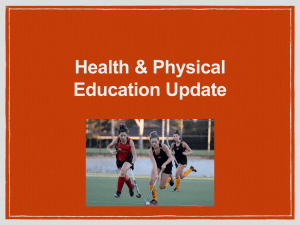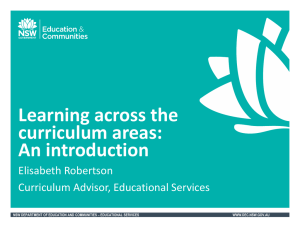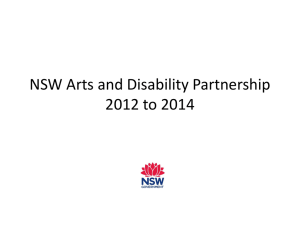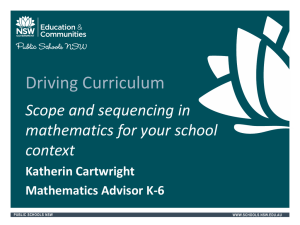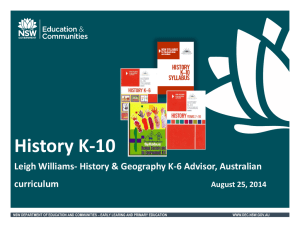Phased implementation of the new Resource Allocation Model (RAM)
advertisement
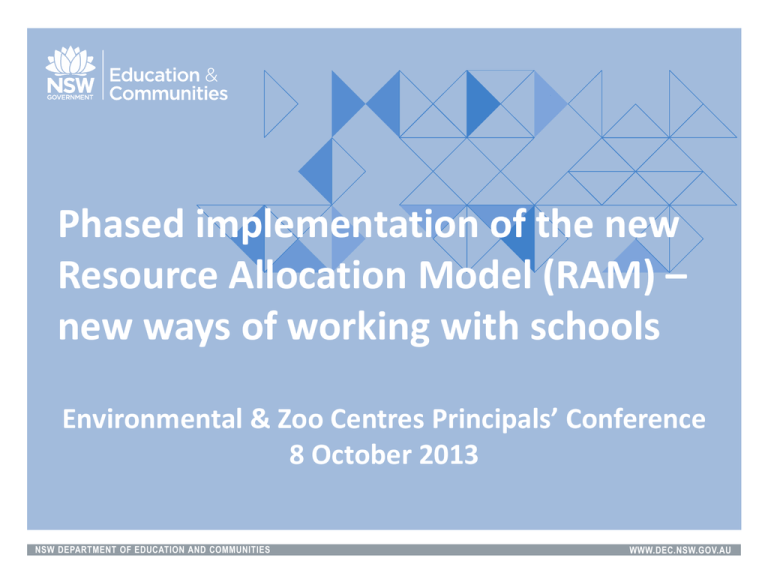
Phased implementation of the new Resource Allocation Model (RAM) – new ways of working with schools Environmental & Zoo Centres Principals’ Conference 8 October 2013 NSW DEPARTMENT OF EDUCATION AND COMMUNITIES WWW.DEC.NSW.GOV.AU NSW DEPARTMENT OF EDUCATION AND COMMUNITIES WWW.DEC.NSW.GOV.AU Effective implementation of RAM requires a phased approach • In 2014 all schools will receive funding from the four Equity Loadings and the Targeted (individual students) components. • This strategy provides a transition pathway that accommodates schools’ current operating environment while delivering significant benefits to the majority of schools. • The first year of phased implementation represents a significant step in the delivery of a new needs based funding model. • The 229 schools participating in the Empowering Local Schools National Partnership (ELS NP) will be the only schools to receive their 2014 funding as a total school allocation and be operating within some aspects of LMBR. NSW DEPARTMENT OF EDUCATION AND COMMUNITIES WWW.DEC.NSW.GOV.AU Operating Environment Current Future Financial Cash accounting, cash allocation, school bank account. Accrual accounting, budget allocation, part of a single banking system. Systems Oasis and OMSEE staff entitlement LMBR integrated payroll/HR/Finance (interim HR interface) Staffing Staffing agreement Award negotiation Staff entitlement New staffing agreement New award negotiation Choosing the mix of staff guidelines Staff Costing School funded staff outside staff entitlement - actual cost Staff funded within staffing or operational resources will be charged at standard cost including 19.5% on-costs. All casual staff and those funded by school and community sourced revenue will be charged at actual cost + 19.5% on-costs. Leave Management Short term casual relief through globals. Some supplementation has been made available to schools. Some types of leave, including LSL, jury, parental, military and special leave will incur no cost to schools. A shared risk model is being developed to protect schools from low occurrence, high impact leave events. NSW DEPARTMENT OF EDUCATION AND COMMUNITIES WWW.DEC.NSW.GOV.AU 4 RAM Target individual students component • Many students face unique and profound challenges that require personalised and customised support. • Dedicated responses are required to support students in whatever settings the students are enrolled. • Resources in this component target individual students • “Funding follows the student” Element To be implemented for all schools in 2014 Targeted (individual students) Funding for students that require high • No change to the or moderate level adjustment for current funding disability, New Arrivals and Refugees, formula and Aboriginal students with high needs • No financial impact at under the existing Norta Norta program. the school or system This includes related staff entitlement at level in 2014. standard cost. NSW DEPARTMENT OF EDUCATION AND COMMUNITIES Impact WWW.DEC.NSW.GOV.AU RAM Equity Loadings • Calculated once as part of planned allocation • Uses prior year data for current year allocation (e.g. uses 2013 data to calculate 2014 allocations) • Changes in student data in the current year will impact funding in the following year • In early Term 4, 2013, all schools will receive advice regarding their Equity loadings for Aboriginal and Socio-economic background Equity Loading Source data for 2014 allocations Low level disability 2013 NAPLAN, 2013 enrolments English language proficiency 2013 ESL survey data Aboriginal background 2013 enrolments Socio-economic background 2013 FOEI and enrolments NSW DEPARTMENT OF EDUCATION AND COMMUNITIES WWW.DEC.NSW.GOV.AU 6 2014 RAM Equity Loadings Component Element To be implemented for all schools in 2014 Aboriginal background Funds all Aboriginal students, more than 49,000 students. (in 2013 approx. 24,000 received some funding). The higher the percentage of Aboriginal students and the greater the number of Aboriginal students in a particular school, the higher the funding. The formula is consistent with the Commonwealth funding model. All schools will receive at least the same level of funding they received in 2013. NSW DEPARTMENT OF EDUCATION AND COMMUNITIES WWW.DEC.NSW.GOV.AU 2014 RAM Equity Loadings Component Element To be implemented for all schools in 2014 Socio-economic background Funds all students (more than 390,000) in the lowest two quarters based on the Family Education and Occupation index (FOEI). Funds students with the highest needs at a higher rate per student. Includes funding commitment to 2014 LSES NP schools. NSW DEPARTMENT OF EDUCATION AND COMMUNITIES WWW.DEC.NSW.GOV.AU Family Occupation and Education index (FOEI) • The equity loading for socio-economic background will be determined by the Family Occupation and Education Index (FOEI). The index is based on the occupation and education status of each student’s primary carers. • FOEI uses information on parental level of school education, highest non-school qualification and occupation category drawn from administrative data collected on enrolment forms and recorded in the Enrolment Registration Number (ERN) system. Data is extracted from ERN in early Term 2 each year. • FOEI scores range from 0 to approximately 300, with a mean of 100. High FOEI scores indicate higher levels of need, i.e. lower socio-economic status. The direction of FOEI scores is opposite to that for the Index of Community Socio-Educational Advantage (ICSEA). NSW DEPARTMENT OF EDUCATION AND COMMUNITIES WWW.DEC.NSW.GOV.AU Why is FOEI the best measure? FOEI provides the best socio-economic index to fit the new school resourcing model and the demographics of NSW government schools. It is better than other measures such as the PSFP index and ICSEA, as FOEI: • is available for all schools • is based on all students enrolled at each school • uses direct student background data plus an established process to deal with missing data • is updated each year to reflect changes in the school population • is specific to NSW government schools. NSW DEPARTMENT OF EDUCATION AND COMMUNITIES WWW.DEC.NSW.GOV.AU What happens with SSPs & hospitals schools? • The FOEI index and FOEI student quarter data for SSPs (except hospital schools) includes all students attending SSPs (i.e. both census and non census enrolments). • SSP schools will receive a low SES loading based on all students including those that remain enrolled in other schools. • Hospital schools will not receive any low SES loading under the RAM. • Hospital schools do not have permanent enrolments and under RAM (and existing allocations) receive a specific allocation that takes into account the changing student population and the relatively higher student need. Generally the school where the student is permanently enrolled continues to provide support to that student whilst they attend the Hospital school. NSW DEPARTMENT OF EDUCATION AND COMMUNITIES WWW.DEC.NSW.GOV.AU How will things be different in 2014? • It is not anticipated that there will be large changes in schools’ funding compared with their current global allocations. • The biggest change will be the Equity Loadings which are being delivered in early in Term 4. • Significant investment in equity funding means schools have additional resources to support student need. • Increased flexibilities = new opportunities to work strategically and differently with schools in the best interest of students. NSW DEPARTMENT OF EDUCATION AND COMMUNITIES WWW.DEC.NSW.GOV.AU How will things be different in 2014? • Aligns with EEC and Zoo Education Centres’ Strategic Directions 2012-014 • Opportunity to design different models of service delivery that consider your local context and: effective resource management (cost sharing) strengthened accountability enhanced financial management ethical decision making within a culture of local decision making productive networking and community engagement NSW DEPARTMENT OF EDUCATION AND COMMUNITIES WWW.DEC.NSW.GOV.AU Further information Visit the Local Schools, Local Decisions in the Reforms section of the DEC internet site at http://www.dec.nsw.gov.au/about-thedepartment/our-reforms/local-schools-localdecisions NSW DEPARTMENT OF EDUCATION AND COMMUNITIES WWW.DEC.NSW.GOV.AU QUESTIONS NSW DEPARTMENT OF EDUCATION AND COMMUNITIES WWW.DEC.NSW.GOV.AU

